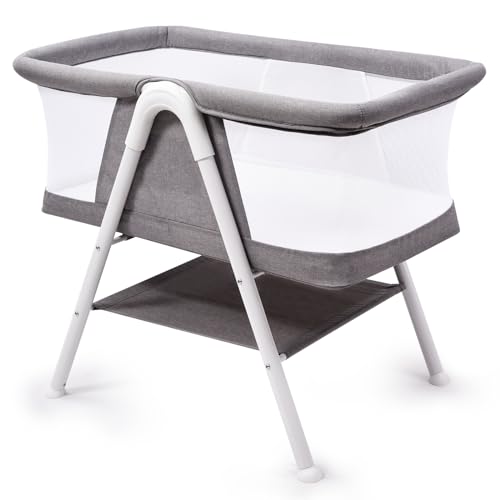The Benefits of Bedside Cribs for Attachment Parenting
Attachment parenting is a child-rearing philosophy that highlights the value of forming a strong psychological bond in between a moms and dad and child. One of the crucial elements of this technique is co-sleeping, which promotes close physical proximity in between parents and their infants. Bedside cribs have gotten significant appeal as a practical and safe sleeping service that enables parents to practice attachment parenting effectively. This article digs into the advantages of bedside cribs, their features, and crucial factors to consider for parents.
What is a Bedside Crib?
A bedside crib, likewise understood as a sidecar crib, is a type of infant sleeping plan that attaches securely to the side of a parent's bed. This design enables the baby to sleep in their own different space while preserving easy access for feeding, comforting, and monitoring. Bedside cribs come in numerous styles, from basic mesh designs to wooden cribs that match the decor of the parents' bedroom.
Secret Features of Bedside Cribs
When considering a bedside crib, it's vital to analyze its functions to guarantee it fits the needs of both moms and dad and baby. Here are some important characteristics to look out for:
| Feature | Description |
|---|---|
| Adjustable Height | Many bedside cribs have adjustable height settings to align with the moms and dad's mattress. |
| Side Panel Access | A side panel that can be lowered enables easy access to the baby during the night. |
| Sturdy Construction | High-quality products, such as strong wood or resilient metal frames, offer stability and safety. |
| Security Features | Search for cribs with safety accreditations and functions such as safe and secure locking mechanisms. |
| Breathable Materials | Bedside cribs often make use of breathable fabrics to promote air flow, minimizing the threat of suffocation. |
Benefits of Bedside Cribs for Attachment Parenting
1. Promotes Bonding
Bedside cribs assist in a nurturing environment where infants can sense their parents' presence, which fosters emotional security and attachment. The close distance helps parents react more quickly to their baby's requirements during sleep, promoting a sense of security and trust.
2. Alleviate of Feeding
For breastfeeding mothers, bedside cribs provide unparalleled benefit for nighttime feeding. Moms can quickly reach their baby without rising, making late-night feedings less disruptive for both parent and child.
3. Decreases Risks Associated with Co-Sleeping
While co-sleeping can promote attachment, it also carries dangers such as suffocation and falling. Bedside cribs offer a compromise, providing a safe sleeping space for the baby while still enabling parents to sleep close by.
4. Better Sleep for Parents
Given that parents can address their baby's requirements without completely waking or leaving the bed, they can maintain much better sleep quality. This is particularly essential during the early months when sleep deprivation can take a toll on adult wellness.
5. Increased Convenience
With a bedside crib, parents can quickly monitor their baby's motions and listen for any nighttime fussing, enabling quicker interventions when essential. This convenience is particularly beneficial for parents requiring to manage their time efficiently.
Selecting the Right Bedside Crib
When choosing a bedside crib that aligns with the principles of attachment parenting, parents should think about several factors:
- Safety Standards: Always select a crib that fulfills safety guidelines and standards to guarantee the infant's wellness.
- Size Compatibility: Ensure the crib fits firmly beside the moms and dad's bed and can be adjusted for height.
- Reduce of Access: Look for features that permit easy side access, specifically useful for breastfeeding.
- Portability: If travel becomes part of family life, consider a crib that is lightweight and quickly transportable.
- Spending plan: Bedside cribs can be found in a variety of rate varieties. There are many budget friendly alternatives that do not compromise on security or quality.
Regularly Asked Questions (FAQs)
Q1: Are bedside cribs safe for newborns?A1: Yes, bedside cribs are developed with security functions to ensure a safe sleeping environment for newborns. Constantly follow the manufacturer's standards and security standards. Q2: Will my baby outgrow a bedside
crib quickly?A2: It depends upon the model. A lot of bedside cribs can accommodate
infants as much as 6-12 months, but it's essential to inspect the weight and height limits defined by the manufacturer. Q3: Can I use a bedside crib if I have a smaller sized bed?A3: Yes, many bedside cribs are adjustable and
can be lined up with various bed sizes. Always make sure the attachment is safe and secure. Q4: How does a bedside crib vary from co-sleeping? A4: Co-sleeping involves sharing the exact same sleep surface area
, while bedside cribs supply a different sleeping
space for the baby, keeping security and promoting attachment. Q5: Can I use a bedside crib if I'm not breastfeeding?A5: Absolutely! Bedside cribs are helpful for all parents and caretakers, making it much easier
to comfort and address a baby, despite feeding methods. Bedside cribs represent a vital tool for parents who embrace attachment parenting. relevant site permit physical nearness but likewise enhance safety and benefit during the newborn phase. Parents must carefully choose a bedside crib that follows safety requirements and fits their way of life, guaranteeing a nurturing environment for both baby and parent. By promoting bonding, ease of feeding, and much better sleep for parents, bedside cribs play a considerable role in fostering the principles of attachment parenting-- a fulfilling journey that nurtures a stronger, loving connection in between parents and their kids.

